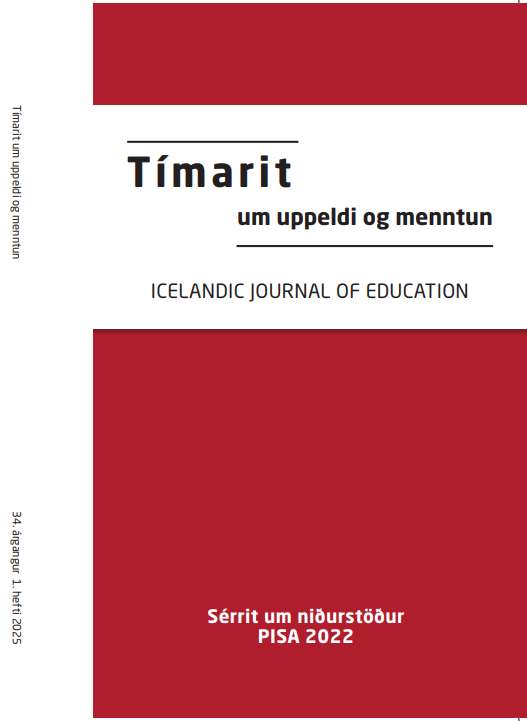The value of arts education in Iceland with a view of the PISA results, part three: creative thinking
DOI:
https://doi.org/10.24270/tuuom.2025.34.2Keywords:
arts, art education, creativity, drama, music, creative thinkingAbstract
In this article, we discuss the value of arts education in Iceland in light of the PISA results on creative thinking, aiming to analyze and summarize the survey’s main findings on creative thinking and place them in the context of research on the importance of arts education and the situation in Icelandic schools. The article also discusses the results of the PISA survey from 2022, in which school administrators answered questions about obstacles to creative schoolwork, within the education system. The PISA results show that overall, Icelandic students’ creative thinking performance was below the average for OECD countries. However, the strength of Icelandic students is their ability to come up with original ideas or solutions, where they performed similarly to their peers in OECD countries. Another strength of Icelandic students is their ability to write stories or work with story ideas, and, in this respect, their performance also corresponded to the average for OECD countries. Students performed significantly better in these tasks than in those involving graphic design or problem-solving. It can, therefore, be concluded that Icelandic schools emphasize creative teaching methods and encourage students to approach problem-solving in an original and creative manner. Different ideas about arts and art education are analyzed with an emphasis on drama and music, and we shed light on different academic and professional views. Knowledge of education, in or through the arts, involves the physical senses or the conceptual or emotional processes, thus providing an aesthetic insight, unlike other fields of study. All children have artistic talents and can be both givers and receivers of art; creativity, imagination, and play are key arts elements. It is all about learning art, learning through art, or learning about art. The authors argue that art should be considered the center of knowledge acquisition in school settings. PISA, vol. III, “Creative Thinking” states that regular participation (at least once a week) in arts such as visual arts, drama, or creative writing is associated with better performance in creative thinking than performing such tasks infrequently or irregularly. It also shows that students with a higher socio-economic status performed better in creative thinking, scoring on average 9.5 points higher than their peers living in poorer conditions within the OECD. This applies to students in OECD countries and to Icelandic students on average. However, the relationship between socioeconomic status and performance is generally weaker in creative thinking than mathematics, reading, or science. The gender gap favors girls in most countries but is the largest in Iceland and Finland on average among OECD countries. These findings on gender differences in performance show that boys need support to demonstrate their creativity. PISA findings on gender differences in creative thinking – showing that girls outperform boys in certain creative tasks – point to the need to address boys’ disadvantage in this area, perhaps partly by supporting their attitudes towards creativity and their participation in creative learning and problem-solving activities. The results indicate that in addition to outperforming boys in creative thinking on the PISA test, girls more often reported having a stronger belief in the nature of their creativity and more positive attitudes towards skills related to creative thinking (OECD, 2024a). Students in Iceland have a strong belief in their own abilities. Students can create new aesthetic knowledge through the arts and deepen their human desires and experiences. Through the arts, students learn critical thinking. In addition, artistic creation enhances inner satisfaction and increases democratic awareness. According to the Icelandic National Curriculum guide (Mennta- og menningarmálaráðuneyti, 2013), arts and crafts are divided into performing arts (i.e., drama and dance), visual arts, and music, and, on the other hand, home economics, design, construction, and textile education. Each individual school decides whether the subjects are taught individually or integrated in shorter phases with more lessons in a timetable during certain periods or continuously throughout the school year (Jóna Guðrún Jónsdóttir og Rannveig Björk Þorkelsdóttir, 2024; Österlind et al., 2016). The reference timetable (from the ministry) stipulates that drama, dance, art, or music should be taught at every age level (Mennta- og menningarmálaráðuneyti, 2013) and should take up about 15% of the weekly teaching (Jóna Guðrún Jónsdóttir og Rannveig Björk Þorkelsdóttir, 2024; Österlind et al., 2016). However, 45% of 15-year-old Icelandic students say they never, or almost never, receive lessons in visual arts; 56% of Icelandic students say they never, or almost never, receive lessons in music, and 53% say they never or almost never receive lessons in drama. Clearly, compulsory schools in Iceland are not fulfilling the reference timetable (from the ministry), which stipulates that drama, dance, art, and music should be taught at every age level from 6 to 16 years old (Mennta- og menningarmálaráðuneyti, 2013).
Downloads
Downloads
Published
Issue
Section
License
Copyright (c) 2025 Rannveig Björk Þorkelsdóttir, Jóna Guðrún Jónsdóttir

This work is licensed under a Creative Commons Attribution 4.0 International License.

This work is licensed under a Creative Commons Attribution 4.0 International License.
